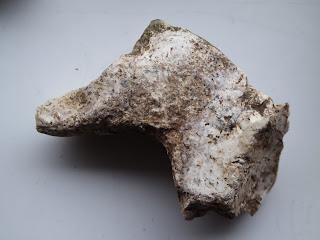Today's Eolith's post on Portable Rock Art is about horse head motifs, these all come from my usual find site. I have shared quite a few figurative examples of worked stones showing suspected horse artworks.
In this old post, the horse head motif almost instantly turns into an impression that looks very much like the head of a Tyrannosaurs Rex (The theory of revolution) and there are more extinct creature impressions to be seen in the stone as well (UK Tortoise - extinct for roughly 35 million years)
One of the key features of the horse head motif found in my figure stones, is the 'mane' feature, many of them have it. Perhaps this is one of the key visual indicators, or 'triggers' used to produce the impression for these prehistoric peoples, or just to make a distinction between another creature with a similar head shape?
The uncluttered flint sculpture below shows the second 'eye' feature just above and to the left of the other one and, also a curved 'muzzle' and 'mouth' impression (mouth along bottom edge), this leaves us with four possible combinations, or ways to view the suspected creature impressions. Pick an 'eye' and pick a 'muzzle' and see for yourselves.
This piece from the previous post is not quite right either, mane, muzzle, ear and profile shape features are all good, but when it comes to choosing a feature for the 'eye' nothing seems to quite fit properly, and we end up with either a dinosaur head impression, or art intending to show the head of an eagle, or something like it.
A very good horse head likeness can be seen in this flint tool, this artifact contains many other motifs, just like almost all the finds displayed on this blog.
One of the key features of the horse head motif found in my figure stones, is the 'mane' feature, many of them have it. Perhaps this is one of the key visual indicators, or 'triggers' used to produce the impression for these prehistoric peoples, or just to make a distinction between another creature with a similar head shape?
The uncluttered flint sculpture below shows the second 'eye' feature just above and to the left of the other one and, also a curved 'muzzle' and 'mouth' impression (mouth along bottom edge), this leaves us with four possible combinations, or ways to view the suspected creature impressions. Pick an 'eye' and pick a 'muzzle' and see for yourselves.
This piece from the previous post is not quite right either, mane, muzzle, ear and profile shape features are all good, but when it comes to choosing a feature for the 'eye' nothing seems to quite fit properly, and we end up with either a dinosaur head impression, or art intending to show the head of an eagle, or something like it.
The worked flint piece below, shows the double sided impression of a seated horse.
The next two pictures are of the same find, I believe the item was hafted using the hole shown in the second picture. Although that would produce something similar to an axe, I'm not of the opinion that it would be very useful for chopping trees, and was more likely a weapon, the blade area is on the lower area of the 'mane'. The photo below is lacking many details, only one of which is the ocher etched 'eye'.
Below are some more worked flint finds from my site, many do seem to roughly translate as to being the horse head motif, although they could just as easily be descriptions of other creatures, some look more like dinosaur impressions or possibly other creature motifs.
















